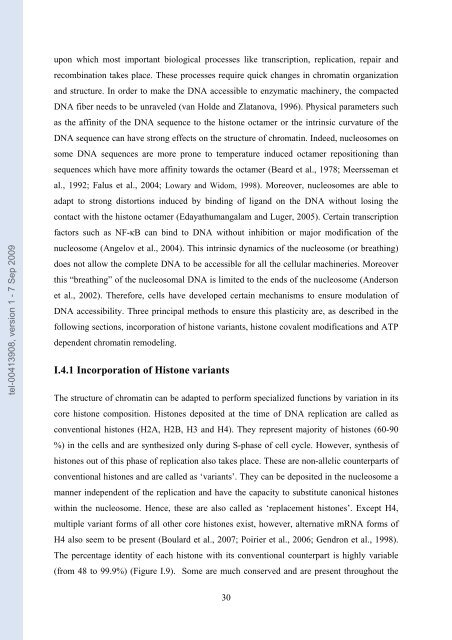Etudes sur le mécanisme de remodelage des nucléosomes par ...
Etudes sur le mécanisme de remodelage des nucléosomes par ...
Etudes sur le mécanisme de remodelage des nucléosomes par ...
Create successful ePaper yourself
Turn your PDF publications into a flip-book with our unique Google optimized e-Paper software.
tel-00413908, version 1 - 7 Sep 2009<br />
upon which most important biological processes like transcription, replication, repair and<br />
recombination takes place. These processes require quick changes in chromatin organization<br />
and structure. In or<strong>de</strong>r to make the DNA accessib<strong>le</strong> to enzymatic machinery, the compacted<br />
DNA fiber needs to be unrave<strong>le</strong>d (van Hol<strong>de</strong> and Zlatanova, 1996). Physical <strong>par</strong>ameters such<br />
as the affinity of the DNA sequence to the histone octamer or the intrinsic curvature of the<br />
DNA sequence can have strong effects on the structure of chromatin. In<strong>de</strong>ed, nuc<strong>le</strong>osomes on<br />
some DNA sequences are more prone to temperature induced octamer repositioning than<br />
sequences which have more affinity towards the octamer (Beard et al., 1978; Meersseman et<br />
al., 1992; Falus et al., 2004; Lowary and Widom, 1998). Moreover, nuc<strong>le</strong>osomes are ab<strong>le</strong> to<br />
adapt to strong distortions induced by binding of ligand on the DNA without losing the<br />
contact with the histone octamer (Edayathumangalam and Luger, 2005). Certain transcription<br />
factors such as NF-κB can bind to DNA without inhibition or major modification of the<br />
nuc<strong>le</strong>osome (Angelov et al., 2004). This intrinsic dynamics of the nuc<strong>le</strong>osome (or breathing)<br />
does not allow the comp<strong>le</strong>te DNA to be accessib<strong>le</strong> for all the cellular machineries. Moreover<br />
this “breathing” of the nuc<strong>le</strong>osomal DNA is limited to the ends of the nuc<strong>le</strong>osome (An<strong>de</strong>rson<br />
et al., 2002). Therefore, cells have <strong>de</strong>veloped certain mechanisms to en<strong>sur</strong>e modulation of<br />
DNA accessibility. Three principal methods to en<strong>sur</strong>e this plasticity are, as <strong>de</strong>scribed in the<br />
following sections, incorporation of histone variants, histone cova<strong>le</strong>nt modifications and ATP<br />
<strong>de</strong>pen<strong>de</strong>nt chromatin remo<strong>de</strong>ling.<br />
I.4.1 Incorporation of Histone variants<br />
The structure of chromatin can be adapted to perform specialized functions by variation in its<br />
core histone composition. Histones <strong>de</strong>posited at the time of DNA replication are cal<strong>le</strong>d as<br />
conventional histones (H2A, H2B, H3 and H4). They represent majority of histones (60-90<br />
%) in the cells and are synthesized only during S-phase of cell cyc<strong>le</strong>. However, synthesis of<br />
histones out of this phase of replication also takes place. These are non-al<strong>le</strong>lic counter<strong>par</strong>ts of<br />
conventional histones and are cal<strong>le</strong>d as ‘variants’. They can be <strong>de</strong>posited in the nuc<strong>le</strong>osome a<br />
manner in<strong>de</strong>pen<strong>de</strong>nt of the replication and have the capacity to substitute canonical histones<br />
within the nuc<strong>le</strong>osome. Hence, these are also cal<strong>le</strong>d as ‘replacement histones’. Except H4,<br />
multip<strong>le</strong> variant forms of all other core histones exist, however, alternative mRNA forms of<br />
H4 also seem to be present (Boulard et al., 2007; Poirier et al., 2006; Gendron et al., 1998).<br />
The percentage i<strong>de</strong>ntity of each histone with its conventional counter<strong>par</strong>t is highly variab<strong>le</strong><br />
(from 48 to 99.9%) (Figure I.9). Some are much conserved and are present throughout the<br />
30

















